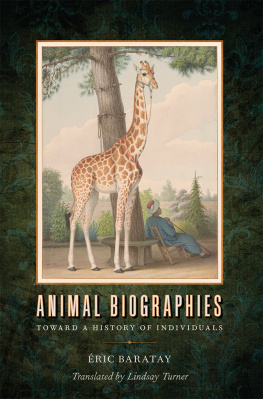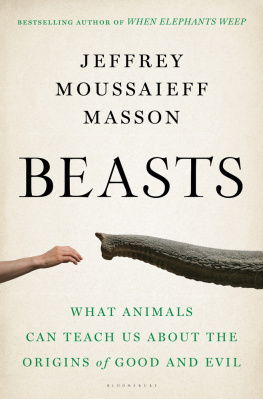The Afterlives of Animals
The Afterlives
of Animals

EDITED BY SAMUEL J. M. M. ALBERTI

University of Virginia Press
2011 by the Rector and Visitors of the University of Virginia
The Afterlife of Chi-Chi Henry Nicholls
All rights reserved
Printed in the United States of America on acid-free paper
First published 2011
9 8 7 6 5 4 3 2 1
Library of Congress Cataloging-in-Publication Data
The afterlives of animals : a museum menagerie /
edited by Samuel J. M. M. Alberti.
p. cm.
Includes bibliographical references and index.
ISBN 978-0-8139-3167-8 (cloth : alk. paper)
ISBN 978-0-8139-3208-8 (ebook)
1. Famous animalsBiography. 2. Famous animals
Collection and preservation. 3. AnimalsBiography.
4. Zoological specimensCollection and preservation.
5. TaxidermyAnecdotes. 6. Animals and civilization
History. 7. Menageries. I. Alberti, Samuel J. M. M.
QL793.A38 2011
590dc22 2011008110
Contents
SAMUEL J. M. M. ALBERTI
CHRISTOPHER PLUMB
SAMUEL J. M. M. ALBERTI
RICHARD SUTCLIFFE, MIKE RUTHERFORD, AND JEANNE ROBINSON
SOPHIE EVEREST
RACHEL POLIQUIN
MERLE PATCHETT, KATE FOSTER, AND HAYDEN LORIMER
HANNAH PADDON
MICHELLE HENNING
HENRY NICHOLLS
RICHARD C. SABIN
GARRY MARVIN
GEOFFREY N. SWINNEY
Acknowledgments
Many people and institutions helped to bring this volume to fruition, and specific thanks can be found in the pages that follow. A number of organizations were generous with resources, staff time, and images, including Bristol City Museum and Art Gallery; the British Museum; Chethams Library, Manchester; the Design Museum; Glasgow Museums; the Great North Museum: Hancock; the Hunterian Museum and Art Gallery, University of Glasgow; the Manchester Museum, University of Manchester; Marine Connection ( www.marineconnection.org ); National Museums Scotland; the Natural History Museum, London; the Wellcome Library, London; and the Yale Center for British Art.
As editor, I could not have asked for a more dedicated, enthusiastic, and amazingly punctual group of contributors. Former colleagues and students at the Centre for Museology suffered my zoological enthusiasms with forbearance. Elsewhere, I have been especially aware of our debt to colleagues and friends including Ebony Andrews, Steve Baker, Fay Bound Alberti, Anna Bunney, Malcolm Chapman, David Craven, Roy Garner, Julie Harvey, Antonio Marcelo Herrera, Angie Hogan, Rebecca Machin, Henry McGhie, Susan McHugh, Steve McLean, Nick Merriman, Irit Narkiss, Adrian Norris, Michael Powell, Maggie Reilly, Liz Sandeman, Hanna Rose Shell, Mark Steadman, Phyllis Stoddart, Liv Emma Thorsen, Myna Trustrum, Clare Valentine, Mick Worboys, and Boyd Zenner. Some of these colleagues were present when the contributors met at the Manchester Museum in December 2009 to present and discuss their contributions. We are grateful to all those who participated in the workshop, which was generously supported by the Manchester Museum; the University of Manchester Centre for the History of Science, Technology and Medicine; and Renaissance North West.
SAMUEL J. M. M. ALBERTI
Introduction
The Dead Ark
One of my favorite natural history exhibits, now sadly extinct, was Abels Ark at the Hancock Museum in Newcastle upon Tyne (now part of the Great North Museum). Faced with a collection of sporting trophy heads inherited from a local Victorian naturalist, twentieth-century curators built an educational display in which the decapitated mounts poked their heads through the window of a jolly ark (see Few displays demonstrate so effectively in a single glance the changing functions of natural history museums and the radical shifts in the meanings of animals: from life on the savannah to a sportsmans prize, from hunting mount to specimen to educational object.
Elsewhere in the serried ranks of other natural history museums, there are many animals that similarly refuse to be constrained by their zoological classification. Their fame in life and their iconic status in death defy taxonomy. They are not only specimens, but also personalities; not only data, but also historical documents. The Afterlives of Animals selects some especially interesting examples and traces their individual histories both before and after death: their movement and meanings in life, how they died, and then how they came to be in collections. By assembling a series of such animal biographies, we are able to trace the shifting meanings (scientific, cultural, emotional) of singular animals and their remains. The stories that follow take us from fields and rivers through zoos and menageries to museums. From Balto the husky to Chi-Chi It is the premise of this volume that those who have custody of dead as well as living animals play crucial roles in this representation, but that their intended interpretations do not always tally with the meanings afforded to animals by visitors.

FIG. 1. Abels Ark at the Hancock Museum, 2005. (Great North Museum: Hancock and the Natural History Society of Northumbria/Steve McLean)
It might seem strange to write biographies not of people but of animals, and even stranger to extend these biographies beyond death, to the preserved remains of these animals that might simply be considered things. But in approaching the singular histories of specific animals, whether as individuals or as objects, we draw on techniques deployed for some time by anthropologists
Here we are especially interested in the fate of these animals after death: their afterlives. Just as animals were mobile, flexible entities with changing meanings as they traveled through sites for living display, so this accrual continues postmortem. We mean afterlife not in the spiritual way, clearly, but rather in the same sense as the conservator Richard Jaeschke in his discussion of the fate of archaeological objects: For the archaeologist, the life of the object is fixed at the moment of its discovery [a notion that could equally be applied to the biological death of an animal for the museum zoologist]. For conservators, however, the situation is not so simple and the life of the object continues. The last of the stages in the career of objects that Jaeschke proposes, somewhat tongue-in-cheek, is the afterlife: during which the object is placed in its heavenly home, the museum or archive, to remain for eternity... [but] the afterlife seldom proves a heavenly resting place and usually involves the object in more adventures and perils. It does not cease to age and to have a history, but its history of use has become a history of treatment. As Geoffrey Swinney reflects in his afterword to this volume, the animals herein have many different kinds of afterlives, in different places and in different media. Afterlives, Swinney shows, are created in the recountingwe ourselves are contributing to this process in this book.
Written by contributors from different disciplines and backgrounds about different species of animals at different times, the accounts that follow nonetheless exhibit some striking parallels. In what remains of this introductory
TRANSITIONS
The list of places visited or inhabited by the animals here would be as long as the book itself, including several countries in at least four continents; rivers, fields and Arctic wilderness; a royal menagerie and a royal college; several zoos, workshops, storage facilities, and numerous museums; as well as all the places we have been unable to recover. And thanks to our biographical perspective, tracing the paths of animals in life, preparation, and exhibition (or not), we are able to show the dynamic links between these different spaces for the experience and display of animals. Furthermore, as shown by most essays herein, representations of particular animals then traveled even farther in print, image, film, and online.
Next page











